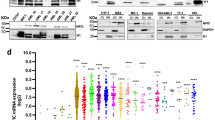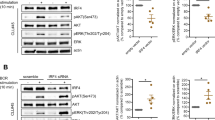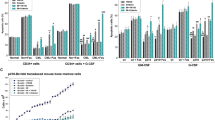Abstract
Functional inducible NOS (iNOS) may be involved in the prolonged lifespan of chronic lymphocytic leukemia cells (B-CLL), although the exact mechanisms implicated remain elusive as yet. In this work, we have examined iNOS expression in normal B lymphocytes and B-CLL cells in pro- and antiapoptotic conditions. Our results demonstrate: (1) The existence of a new splice variant characterized by a complete deletion of exon 14 (iNOS 13–1614del), which was preferentially detected in normal B lymphocytes and may represent an isoform that could play a role in the regulation of enzyme activity. (2) The existence of another alternatively spliced iNOS mRNA transcript involving a partial deletion of the flavodoxin region (iNOS 13–16neg) was correlated to a decreased B-CLL cell viability. The 9-β-D-arabinofuranosyl-2-fluoradenine or fludarabine (F-ara) treatment induced iNOS 13–16neg transcript variants, whereas IL-4 enhanced both the transcription of variants, including these exons (iNOS 13–16pos), and the expression of a 122 kDa iNOS protein. These results suggest that in B-CLL, a regulation process involving nitric oxide (•NO) levels could occur by a post-transcriptional mechanism mediated by soluble factors. Our results also provide an insight into a new complementary proapoptotic action of F-ara in B-CLL by the induction of particular iNOS splice variants, leading to the activation of a caspase-3-dependent apoptotic pathway.
This is a preview of subscription content, access via your institution
Access options
Subscribe to this journal
Receive 12 print issues and online access
$259.00 per year
only $21.58 per issue
Buy this article
- Purchase on Springer Link
- Instant access to full article PDF
Prices may be subject to local taxes which are calculated during checkout





Similar content being viewed by others
References
Dameshek W . Chronic lymphocytic leukemia an accumulative disease of immunolgically incompetent lymphocytes. Blood 1967; 29 (Suppl.): 566–584.
Reed JC . Molecular biology of chronic lymphocytic leukemia. Semin Oncol 1998; 25: 11–18.
Keating MJ . Chronic lymphocytic leukemia. Semin Oncol 1999; 26: 107–114.
Collins RJ, Verschuer LA, Harmon BV, Prentice RL, Pope JH, Kerr JF . Spontaneous programmed death (apoptosis) of B-chronic lymphocytic leukaemia cells following their culture in vitro. Br J Haematol 1989; 71: 343–350.
Mainou-Fowler T, Prentice AG . Modulation of apoptosis with cytokines in B-cell chronic lymphocytic leukaemia. Leukemia Lymphoma 1996; 21: 369–377.
Panayiotidis P, Jones D, Ganeshaguru K, Foroni L, Hoffbrand AV . Human bone marrow stromal cells prevent apoptosis and support the survival of chronic lymphocytic leukaemia cells in vitro. Br J Haematol 1996; 92: 97–103.
Castejon R, Vargas JA, Romero Y, Briz M, Munoz RM, Durantez A . Modulation of apoptosis by cytokines in B-cell chronic lymphocytic leukemia. Cytometry 1999; 38: 224–230.
Jewell AP, Worman CP, Lydyard PM, Yong KL, Giles FJ, Goldstone AH . Interferon-alpha up-regulates bcl-2 expression and protects B-CLL cells from apoptosis in vitro and in vivo. Br J Haematol 1994; 88: 268–274.
Panayiotidis P, Ganeshaguru K, Jabbar SA, Hoffbrand AV . Alpha-interferon (alpha-IFN) protects B-chronic lymphocytic leukaemia cells from apoptotic cell death in vitro. Br J Haematol 1994; 86: 169–173.
Panayiotidis P, Ganeshaguru K, Jabbar SA, Hoffbrand AV . Interleukin-4 inhibits apoptotic cell death and loss of the bcl-2 protein in B-chronic lymphocytic leukaemia cells in vitro. Br J Haematol 1993; 85: 439–445.
Dancescu M, Rubio-Trujillo M, Biron G, Bron D, Delespesse G, Sarfati M . Interleukin 4 protects chronic lymphocytic leukemic B cells from death by apoptosis and upregulates Bcl-2 expression. J Exp Med 1992; 176: 1319–1326.
Chaouchi N, Wallon C, Goujard C, Tertian G, Rudent A, Caput D et al. Interleukin-13 inhibits interleukin-2-induced proliferation and protects chronic lymphocytic leukemia B cells from in vitro apoptosis. Blood 1996; 87: 1022–1029.
Reittie JE, Yong KL, Panayiotidis P, Hoffbrand AV . Interleukin-6 inhibits apoptosis and tumour necrosis factor induced proliferation of B-chronic lymphocytic leukaemia. Leukemia Lymphoma 1996; 22: 83–90.
Francia di Celle P, Mariani S, Riera L, Stacchini A, Reato G, Foa R . Interleukin-8 induces the accumulation of B-cell chronic lymphocytic leukemia cells by prolonging survival in an autocrine fashion. Blood 1996; 87: 4382–4389.
Brune B, von Knethen A, Sandau KB . Nitric oxide and its role in apoptosis. Eur J Pharmacol 1998; 351: 261–272.
Dimmeler S, Zeiher AM . Nitric oxide and apoptosis: another paradigm for the double-edged role of nitric oxide. Nitric Oxide 1997; 1: 275–281.
Nicotera P, Brune B, Bagetta G . Nitric oxide: inducer or suppressor of apoptosis? Trends Pharmacol Sci 1997; 18: 189–190.
Mannick JB, Asano K, Izumi K, Kieff E, Stamler JS . Nitric oxide produced by human B lymphocytes inhibits apoptosis and Epstein–Barr virus reactivation. Cell 1994; 79: 1137–1146.
Brito C, Naviliat M, Tiscornia AC, Vuillier F, Gualco G, Dighiero G et al. Peroxynitrite inhibits T lymphocyte activation and proliferation by promoting impairment of tyrosine phosphorylation and peroxynitrite-driven apoptotic death. J Immunol 1999; 162: 3356–3366.
Moncada S, Palmer RM, Higgs EA . Nitric oxide: physiology, pathophysiology, and pharmacology. Pharmacol Rev 1991; 43: 109–142.
Zhao H, Dugas N, Mathiot C, Delmer A, Dugas B, Sigaux F et al. B-cell chronic lymphocytic leukemia cells express a functional inducible nitric oxide synthase displaying anti-apoptotic activity. Blood 1998; 92: 1031–1043.
Kolb JP, Roman V, Mentz F, Zhao H, Rouillard D, Dugas N et al. Contribution of nitric oxide to the apoptotic process in human B cell chronic lymphocytic leukaemia. Leukemia Lymphoma 2001; 40: 243–257.
Taylor BS, Geller DA . Molecular regulation of the human inducible nitric oxide synthase (iNOS) gene. Shock 2000; 13: 413–424.
Ganster RW, Geller DA . Regulation of the expression of NOS isoform. In: Ignarro LJ (ed). Nitric Oxide: Biology and Pathobiology, 1st edn. San Diego: Academic Press, 2000, pp. 129–156.
Chartrain NA, Geller DA, Koty PP, Sitrin NF, Nussler AK, Hoffman EP et al. Molecular cloning, structure, and chromosomal localization of the human inducible nitric oxide synthase gene. J Biol Chem 1994; 269: 6765–6772.
Eissa NT, Strauss AJ, Haggerty CM, Choo EK, Chu SC, Moss J . Alternative splicing of human inducible nitric-oxide synthase mRNA. Tissue-specific regulation and induction by cytokines. J Biol Chem 1996; 271: 27184–27187.
Keating MJ, O'Brien S, Lerner S, Koller C, Beran M, Robertson LE et al. Long-term follow-up of patients with chronic lymphocytic leukemia (CLL) receiving fludarabine regimens as initial therapy. Blood 1998; 92: 1165–1171.
Robak T, Kasznicki M . Alkylating agents and nucleoside analogues in the treatment of B cell chronic lymphocytic leukemia. Leukemia 2002; 16: 1015–1027.
Genini D, Adachi S, Chao Q, Rose DW, Carrera CJ, Cottam HB et al. Deoxyadenosine analogs induce programmed cell death in chronic lymphocytic leukemia cells by damaging the DNA and by directly affecting the mitochondria. Blood 2000; 96: 3537–3543.
Catapano CV, Perrino FW, Fernandes DJ . Primer RNA chain termination induced by 9-beta-D-arabinofuranosyl-2-fluoroadenine 5′-triphosphate. A mechanism of DNA synthesis inhibition. J Biol Chem 1993; 268: 7179–7185.
Yang SW, Huang P, Plunkett W, Becker FF, Chan JY . Dual mode of inhibition of purified DNA ligase I from human cells by 9-beta-D-arabinofuranosyl-2-fluoroadenine triphosphate. J Biol Chem 1992; 267: 2345–2349.
Binet JL, Auquier A, Dighiero G, Chastang C, Piguet H, Goasguen J et al. A new prognostic classification of chronic lymphocytic leukemia derived from a multivariate survival analysis. Cancer 1981; 48: 198–206.
Chomczynski P, Sacchi N . Single-step method of RNA isolation by acid guanidinium thiocyanate–phenol–chloroform extraction. Anal Biochem 1987; 162: 156–159.
Levesque MC, Misukonis MA, O'Loughlin CW, Chen Y, Beasley BE, Wilson DL et al. IL-4 and interferon gamma regulate expression of inducible nitric oxide synthase in chronic lymphocytic leukemia cells. Leukemia 2003; 17: 442–450.
Kolb JP . Mechanisms involved in the pro- and antiapoptotic role of NO in human leukemia. Leukemia 2000; 14: 1685–1694.
Beltran B, Mathur A, Duchen MR, Erusalimsky JD, Moncada S . The effect of nitric oxide on cell respiration: a key to understanding its role in cell survival or death. Proc Natl Acad Sci USA 2000; 97: 14602–14607.
Eissa NT, Haggerty CM, Palmer CD, Patton W, Moss J . Identification of residues critical for enzymatic activity in the domain encoded by exons 8 and 9 of the human inducible nitric oxide synthase. Am J Respir Cell Mol Biol 2001; 24: 616–620.
Eissa NT, Yuan JW, Haggerty CM, Choo EK, Palmer CD, Moss J . Cloning and characterization of human inducible nitric oxide synthase splice variants: a domain, encoded by exons 8 and 9, is critical for dimerization. Proc Natl Acad Sci USA 1998; 95: 7625–7630.
Rao KM . Molecular mechanisms regulating iNOS expression in various cell types. J Toxicol Environ Health B Crit Rev 2000; 3: 27–58.
Frank DA, Mahajan S, Ritz J . B lymphocytes from patients with chronic lymphocytic leukemia contain signal transducer and activator of transcription (STAT) 1 and STAT3 constitutively phosphorylated on serine residues. J Clin Invest 1997; 100: 3140–3148.
Kneitz C, Goller M, Seggewiss R, Yaman A, Serfling E, Tony HP . STAT6 and the regulation of CD23 expression in B-chronic lymphocytic leukemia. Leukemia Res 2000; 24: 331–337.
Zheng Z, Venkatapathy S, Rao G, Harrington CA . Expression profiling of B cell chronic lymphocytic leukemia suggests deficient CD1-mediated immunity, polarized cytokine response, altered adhesion and increased intracellular protein transport and processing of leukemic cells. Leukemia 2002; 16: 2429–2437.
Mu X, Kay NE, Gosland MP, Jennings CD . Analysis of blood T-cell cytokine expression in B-chronic lymphocytic leukaemia: evidence for increased levels of cytoplasmic IL-4 in resting and activated CD8T cells. Br J Haematol 1997; 96: 733–735.
Mainou-Fowler T, Miller S, Proctor SJ, Dickinson AM . The levels of TNF alpha, IL4 and IL10 production by T-cells in B-cell chronic lymphocytic leukaemia (B-CLL). Leukemia Res 2001; 25: 157–163.
Kolodziejski PJ, Musial A, Koo JS, Eissa NT . Ubiquitination of inducible nitric oxide synthase is required for its degradation. Proc Natl Acad Sci USA 2002; 99: 12315–12320.
Musial A, Eissa NT . Inducible nitric-oxide synthase is regulated by the proteasome degradation pathway. J Biol Chem 2001; 276: 24268–24273.
Coers W, Timens W, Kempinga C, Klok PA, Moshage H . Specificity of antibodies to nitric oxide synthase isoforms in human, guinea pig, rat, and mouse tissues. J Histochem Cytochem 1998; 46: 1385–1392.
Acknowledgements
This work was supported in part by grants from Comisión Honoraria de Lucha contra el Cáncer, CSIC (Universidad de la República, Uruguay), Schering Uruguaya and Fundación Manuel Pérez. We thank Rafael Radi, Sergio Bianchi, Nicolás Arrambide, Gerard Dumas and Yuri Vasconcelos for critical discussion.
Author information
Authors and Affiliations
Rights and permissions
About this article
Cite this article
Tiscornia, A., Cayota, A., Landoni, A. et al. Post-transcriptional regulation of inducible nitric oxide synthase in chronic lymphocytic leukemia B cells in pro- and antiapoptotic culture conditions. Leukemia 18, 48–56 (2004). https://doi.org/10.1038/sj.leu.2403169
Received:
Accepted:
Published:
Issue Date:
DOI: https://doi.org/10.1038/sj.leu.2403169
Keywords
This article is cited by
-
Inducible Nitric Oxide Synthase Does Not Mediate Brain Damage after Transient Focal Cerebral Ischemia in Mice
Journal of Cerebral Blood Flow & Metabolism (2008)
-
Increased mitochondrial biogenesis in primary leukemia cells: the role of endogenous nitric oxide and impact on sensitivity to fludarabine
Leukemia (2004)



